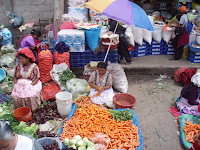 The cover of this past Saturday's edition of the island's most widely read newspaper, El Nuevo Día, read "Cada día más gordos" (translation: "Everyday more Fat People"). The title of the main article was "Una isla de obesos" (translation: "An Island of the Obese"). The rhetoric sounds dramatic and unsophisticated for a major news publication, but it paints an accurate picture of the situation we face on the island. Here are some alarming statistics published in the article:
The cover of this past Saturday's edition of the island's most widely read newspaper, El Nuevo Día, read "Cada día más gordos" (translation: "Everyday more Fat People"). The title of the main article was "Una isla de obesos" (translation: "An Island of the Obese"). The rhetoric sounds dramatic and unsophisticated for a major news publication, but it paints an accurate picture of the situation we face on the island. Here are some alarming statistics published in the article:- 80% of Puerto Rico's population will be obese in 2040
- 42% of Puerto Rico's population currently obese or in danger of being obese
- 32% of children in Puerto Rico who are 4 to 22 months old who are obese
Eating healthy is difficult and costly in Puerto Rico, as I've also mentioned in a previous post. Purchasing fruit and vegetables can be quite expensive, as the island imports most of its foodstuffs. Fast food chains are cheap and pervasive. Furthermore, if the island had more green, open areas for people to walk, run or bike, I believe it would motivate people to lead more active lifestyles. Unfortunately, the local government has not done enough to raise awareness of the obesity problem. With a sinking health care system, the island cannot afford to have an ailing population.
(Image above obtained from El Nuevo Día)






